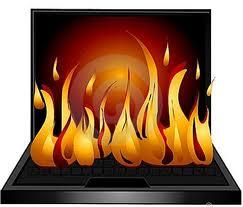 The hot days of summer are associated with swimming, BBQs, and other good times. However, it is no fun when your laptop overheats. Here are a couple of things to do when your computer becomes too hot to handle:
The hot days of summer are associated with swimming, BBQs, and other good times. However, it is no fun when your laptop overheats. Here are a couple of things to do when your computer becomes too hot to handle:
- Check the fan. A lot of computers rely on the fan for cooling. Fans can be fragile (which is why AMREL avoids using them in most of our rugged platforms). Make sure your fan is working.
- Blast the vents with air. If you live with a dog, a cat, or in a dusty area, your vents could be clogged. Get a can of air and unclog the vents. Make sure that your laptop’s power is turned off, and blow the air in at an angle; you do not want to blast the dust further into your laptop. AMREL computers are designed to be used in dirty, dusty areas, so we made them without vents. WARNING: Cooling the hard drive quickly can damage it.
- Turn down the room’s temperature. There is reason why rooms with big servers use a ton of electricity for air conditioning. This step may not be practical for everyone,
- Give your laptop a break. Turn it off completely (not just hibernation mode). There is an age-old debate about whether or not to turn off your personal computer, but there is no doubt that completely powering down gives it a chance to cool off.
- Adjust Power Options. Go to the Power Options section of your Control Panel. Assuming you are not using a lot of data-heavy programs, such as videos or games, you can change the default mode to “Power Savings.” Less power means less heat.
- Get your laptop off its rear end. Buying a laptop cooling station with fans is one option. So is putting a laptop on a cookie sheet, or some other ventilated surface.
- Check the battery. Technical fixes have rendered exploding, overheating batteries a thing of the past. However, if you are using an old computer or battery, you may want to examine it.
- Go to Windows Task Manager. Look at the Processes tab, and close down any unnecessary programs. If the Performance tab shows the CPU acting at 100% all the time, you may have a virus/malware problem.
If all these steps prove fruitless, you should take your laptop to a computer repair professional.





